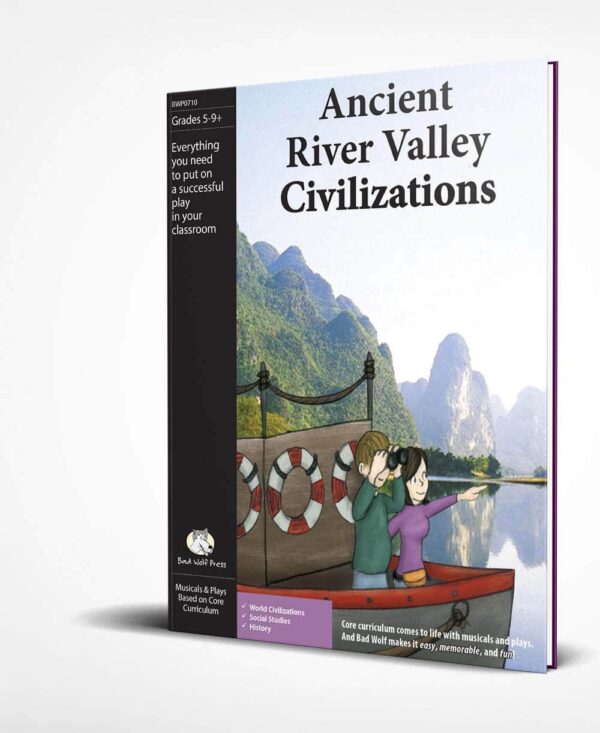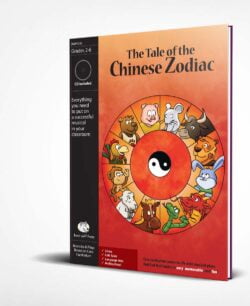 |
An easy, flexible, 45-minute play for grades 5-9+. This is a NON-musical that comes with the script and a teacher's guide. No drama experience needed! |
 |
✓ Funny script ✓ Lots of curriculum ✓ Flexible casting ✓ Dumb jokes
A non-musical tour through the ancient river valley civilizations of Mesopotamia, Egypt, India, and China. Learn more! |
Play (Non-Musical): “Ancient River Valley Civilizations”
Complete Script: $35 (other items also available)

We sell wonderful, short, funny plays and musicals for use in your classroom, after-school program, drama club, music class, summer school program, homeschool, and any other place where kids can thrive by participating in theater! If you are not familiar with us or how to use theater to teach, check out our Q&As.
Synopsis
Who knew that an "all-inclusive" river cruise might include time travel? These lucky tourists will learn all about river valley civilizations from the peoples of those ancient cultures...and some helpful (and hungry) tour guides!
Preview the script and songs!Key Concepts
- Commonalities between the ancient river valley civilizations, how they formed, and why they thrived
- Details about each civilization, including geography, writing systems, religious beliefs, agriculture, technological developments, governance, social structure, and material remains
Specific content/characters emphasized in the play:
Egypt
- Pyramids at Giza
- Pharoahs (Khufu, Tutankhamun, Hatshepsut)
Indus Valley (Harappa)
- Advanced sanitation system
Mesopotamia
- Fertile Crescent
- Sumerian, Akkadian, Assyrian, and Babylonian civilizations
- Hammurabi and his Code
- Mythology and epic (Gilgamesh)
China
- Taoism (Lao Tzu)
- Dynasties (Wu of Zhou)
- Mandate of Heaven
Other Important Terms
| hydraulic empire | agrarian | urbanization | social stratification | hieroglyphs |
| papyrus | Rosetta Stone | sarcophagus | grave goods | aridification |
| ziggurat | cuneiform | Silk Road | oracle bones | monotheism |
| polytheism | loess |
Ancient River Valley Civilizations is a great complement to your curriculum resources in world history and social studies. And, like all of our plays, this show can be used to improve reading, vocabulary, reading comprehension, performance skills, class camaraderie and teamwork, and numerous social skills (read about it!) -- all while enabling students to be part of a truly fun and creative experience they will never forget!
Aligned with national standards! View the standards and vocabulary.Publication Info
Author: Written by John Heath and Lisa Adams
ISBN:
978-1-886588-71-4
© 2018
Bad Wolf Press, LLC
1 review for Play (Non-Musical): “Ancient River Valley Civilizations”
You must be logged in to post a review.
The Show
We want you to know what you're getting, so the cast list and first third of the script are available here! Bad Wolf shows are written for flexibility and can be edited however you like to meet the needs of your actors, school, curriculum, parents, astrological chart, latest whim, etc. If you have questions about the portions of the script not shown, please contact us.
Casting
CHARACTERS:
Maya
Bart
Tourists (4)
Umpires (2)
King Khufu
Scribes (2)
Architect
King Tut
(Egyptian) Woman
Plumbers (3)
Hatshepsut
Ninsun
Gilgamesh
Enkidu
Hammurabi
Clerks (2)
Lao-Tzu
Student
Wu Wang
Benjamin Franklin
(Chinese) Wife
Flexible casting: There are 29 parts, but the play can work with anywhere from 11-35 actors. For a smaller cast, each actor can play several roles and/or individual scenes can be cut. For a larger cast, larger roles (such as Maya, Bart, and the Tourists) can be split amongst multiple actors. Note that all roles can be played by any gender.
Script
This is the first one-third of the script.
Scene One
(MAYA and BART lead four TOURISTS onto the stage)
MAYA: Hello, everyone. My name is Maya, and I will
be your tour guide today. This is Bart, my assistant.
BART (officially, holding a clipboard): Howdy! Before
we embark, I want to cover our three basic safety rules.
First, no souvenirs. We're going into the past, and if you
touch even one tiny thing, you could warp the entire
space-time continuum.
TOURIST #1: What's that?
BART: I have no idea. I just read what's on the clipboard.
(tapping clipboard)
TOURIST #2 (raising hand): If someone warps the space-time
continuum, do we get a refund?
MAYA: I'm afraid not. It's all in the fine print.
BART: Rule number two: do not feed the animals.
TOURIST #3 (holding up cookie): Not even a cookie?
BART: Absolutely not. On our last tour, someone gave the Sphinx
a cookie and it followed us to China and refused to go home. The
Egyptians were furious.
(TOURIST #3 crams cookie in own mouth)
BART: Last rule: keep your hands inside the boat at all times.
Otherwise they could be eaten by a crocodile or a dragon, and that
would violate rules 1 and 2. Any questions?
TOURIST #1: There's a boat?
TOURIST #4: Well yes, of course there's a boat! We're going on a
tour of ancient river civilizations.
TOURIST #1: Oh! I thought this was one of those darling rides
with dancing animatronic cavemen.
MAYA: Oh no. This is a first-class tour. We will be visiting the
ancient civilizations that developed in Egypt, China, Mesopotamia,
and the Indus Valley.
TOURIST #2 (to #1): That's why it costs so much.
MAYA: And we will not be seeing any cavemen, animatronic or
otherwise! We're only going back 5000 years or so.
TOURIST #3: How's this time-travel thing work?
BART: Good question, I'm glad you asked.
(pause)
I have no idea.
TOURIST #4 (rising): If I may? I'm sort of a time travel buff, and
according to the latest ideas by theoretical physicists...
MAYA (interrupting): Oh my, look at the time! It's time to hit the
water. Everyone on the boat!
Scene Two
(MAYA, BART, and TOURISTS are on the "boat")
MAYA: Our first stop will be the Nile River in ancient Egypt.
But before we arrive and meet our local guides, I've invited some
specialists to explain why these great civilizations all developed in
river valleys. Bart, would you bring them in?
BART: I got 'em right here.
(BART goes to edge of stage, leads on two figures dressed as
baseball umpires.)
MAYA (puzzled): Bart! Who are they? I asked you to find experts
on hydraulic empires!
BART: Oh. These guys are hydraulic UMpires. They were a lot
cheaper.
TOURIST #2 (to #1): Look how they cut costs and still charge us a
premium! Hydraulic umpires, indeed!
UMPIRE #1: Hey, don't let that be a strike
against us. We also know all about hydraulic
empires.
UMPIRE #2: They were civilizations that
grew up along rivers -- that's the "hydraulic"
part -- and developed into powerful empires.
They were a big hit!
UMPIRE #1: Rivers supplied water for
drinking and cooking, transportation,
crops, and fishing, and they also attracted
wild game. Basically they were a home run.
MAYA: You're not going to use baseball metaphors for everything,
are you?
UMPIRE #2: Of course not. Now see, at first there were just small
communities along the river -- minor league stuff. But folks needed
to control the water -- manage the flooding or develop irrigation.
UMPIRE #1: And that took coordination and centralized
planning, am I right? Before you knew it, some folks were in charge
of others, and they were the bosses calling the shots. Sometimes
they were priests, sometimes they were kings, sometimes both.
Man oh man, it was a whole new ballgame.
MAYA: Please, I'm begging you...
UMPIRE #2: Then, as agriculture flourished, there came a surplus
of goods. And that threw a curveball into the simple agrarian life.
UMPIRE #1: You said it. What you had in these growing cities
was basic urbanization. Some folks became merchants or traders,
so right off the bat some people started to accumulate more stuff
than others. So then you got social stratification, where people had
different amounts of resources and power.
UMPIRE #2: Now hold on, you're a little off base there. In some
places you got that, like in ancient Egypt and Mesopotamia. But it's
not so clear in the Indus River civilizations.
UMPIRE #1: Good call. Well, I think we've pretty much covered all
the bases on these hydraulic empires, but we're happy to field some
questions.
TOURIST #1 (raises hand): I get the hydraulic part, but what
exactly is an "empire"?
TOURIST #4 (rising): If I may? An empire is basically a big
collection of states or countries all under the control of one
authority.
UMPIRE #1 (to TOURIST #4): Batting a thousand, my man! (to
ALL) An empire starts when cities grow and trade with each other.
You get some competition, some good healthy competition.
UMPIRE #2: But sooner or later, one of them starts to play
hardball. You get a fight, one conquers the other. If things keep
going on like that...eventually you've got an empire.
TOURIST #4: Actually, I would say it's all a bit more complicated
than that --
UMPIRE #1: Sure, but our sketch is in the ballpark. We'd be happy
to stay for a few days and hash it all out.
MAYA: NO! I mean, no thank you, you've done an excellent job.
Bart, can you escort them back to wherever you found them?
Scene Three
TOURIST #1 (pointing): Hey, isn't that a pyramid?
TOURIST #3: How exciting! But it's only half a pyramid!
TOURIST #2: Do we get a discount?
MAYA: We've made it back to Egypt nearly 5000 years ago. This
time period is called the Old Kingdom. They are in the process of
building the first great pyramid at Giza.
TOURIST #1: So this is one of those ancient river civilizations?
MAYA: Absolutely! This is the Nile
River valley. The Nile is over 4000
miles long, and nearly a quarter
of that flows through Egypt. That
pyramid you see there will eventually
be 500 feet tall, and there will be two
others next to it!
KHUFU (entering with two
SCRIBES): Isn't it beautiful? It's
going to be my tomb.
TOURIST #3: Hey look, it's King
Tut!
KHUFU: Not this again! Why oh why do all these people think
every pharaoh they meet is King Tut?
SCRIBE #1: This is King Khufu, the great pharaoh of the fourth
dynasty of the Old Kingdom, in the 26th century BCE.
SCRIBE #2: And we are his Scribes.
TOURIST #1: What's BCE? A band? A nutritional supplement?
TOURIST #4: BCE means Before Common Era. The time before
the year 1.
TOURIST #3: Well are you related to King Tut?
KHUFU (puffing out chest, with pride): No! I lived a thousand
years before that guy! I am King of Upper and Lower Egypt,
mediator between all Egyptians and the gods. And when I die, I
will become a god.
(to SCRIBE)
Why aren't you writing this down? You're a scribe, for Pete's sake!
SCRIBE #2 (jumps to it): Oops. Sorry!
(starts jotting things down furiously)
TOURIST #4: Actually, it's scientifically impossible for you to
become a god when you die --
MAYA: Shh. We're here to learn, not argue.
SCRIBE #1: We Egyptians believe that the king controls everything
in this life, and with the proper burial he will join the gods.
SCRIBE #2: Take the Nile. It flows for hundreds of miles from the
south towards the delta and out into the Mediterranean Sea. Every
year it swells with the rains from central Africa and overflows its
banks, leaving a rich deposit of soil. We call this soil the "black
land."
SCRIBE #1: Without that annual flood, we'd have nothing but
desert, or the "red land." Our Western desert, which you call the
Sahara, is the largest in the world.
(This concludes the first one-third of the script.)
Standards
Common Core and Other National Standards
History/Social Studies
- National World History Standards, Era 2, for 5th-12th
- National Social Studies Standards 1, 2, 3, 5, 6, 7, 8 and 10
- Common Core Grades 6-12 Literacy in History/Social Studies, Science, & Technical Subjects
Language Arts
- Common Core Reading Standards for Literature: 5th, 6th, 7th, 8th, 9th-10th
- Common Core Reading Standards: Foundational Skills:
- 5th: Phonics and Word Recognition, Fluency
- Common Core Speaking and Listening Standards: Comprehension and Collaboration -5th, 6th, 7th, 8th
- Common Core Language Standards: Vocabulary Acquisition and Use -5th, 6th, 7th, 8th, 9th-10th
- Common Core Standard 10: Range, Quality & Complexity:
National Core Arts Standards
- Theater - Anchor Standards 3-6









Verified owner Robin Quiles (verified owner) –
My fifth grade class performed this play for our school and their parents. The play covered our history curriculum perfectly. Due to time constraints we had to cut one scene. We had 9 actors. We were able to keep our costumes simple, yet accurate. Our art department built a boat out of cardboard and our students painted backdrops to coincide with the civilizations. The play was both educational and comical. From behind the stage I could hear roars of laughter from the audience. The students were proud to perform such well written material. Bravo to the writers!! I look forward to using another Bad Wolf Press production next year!